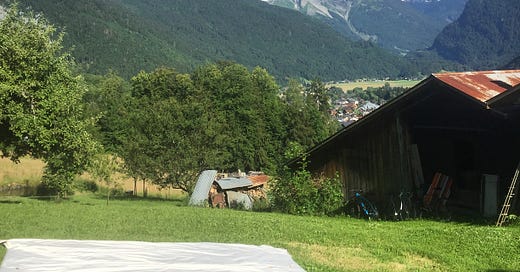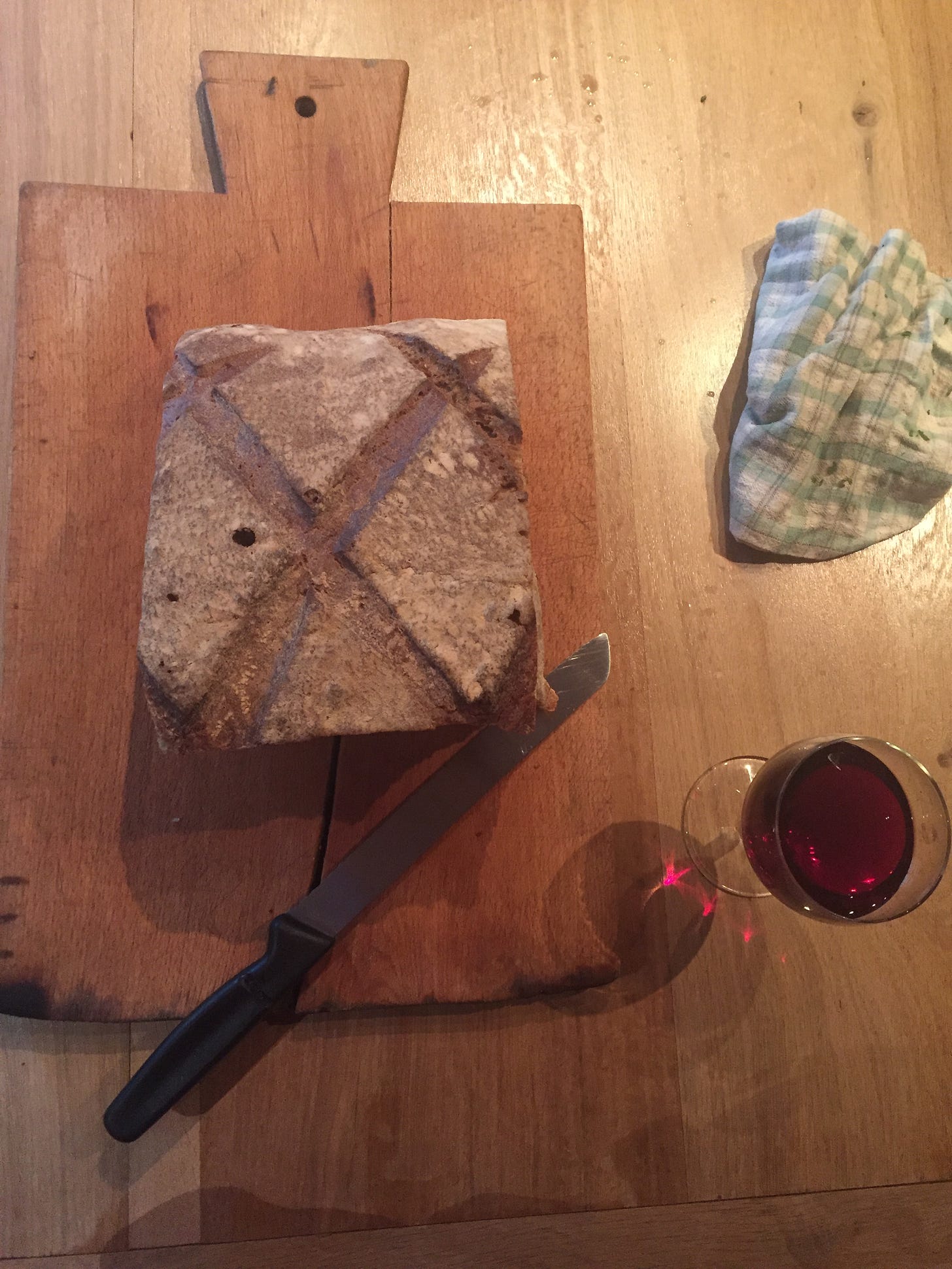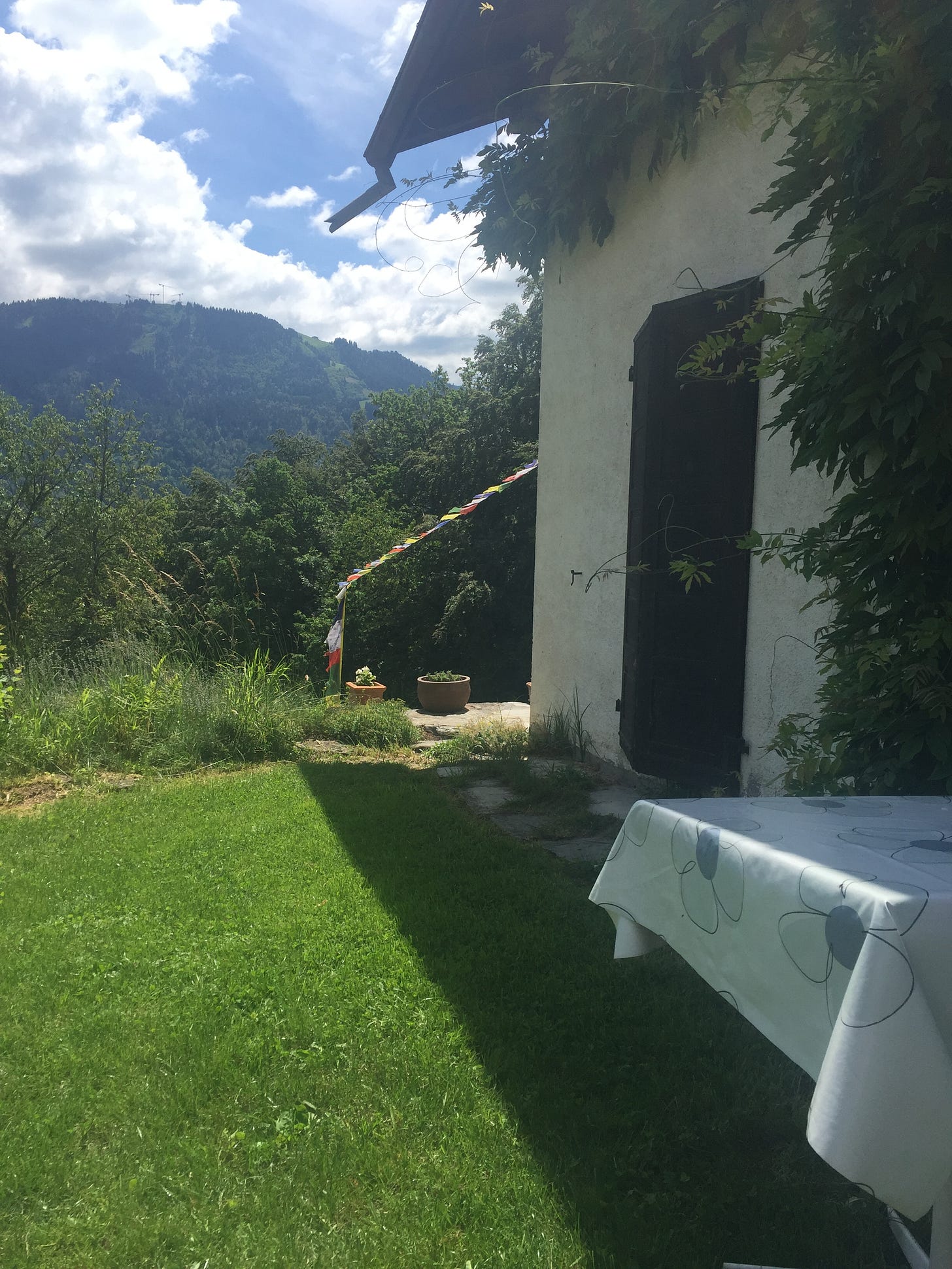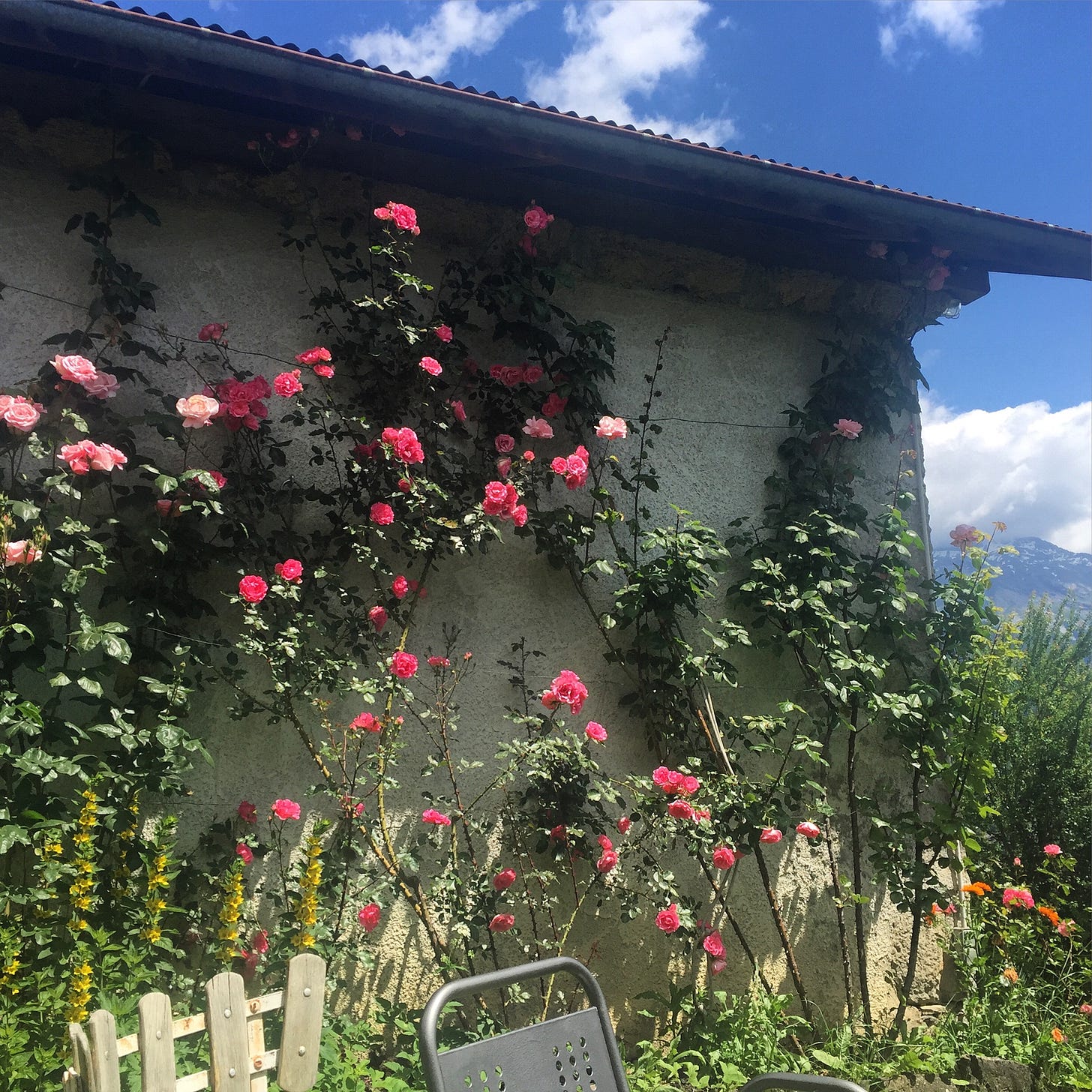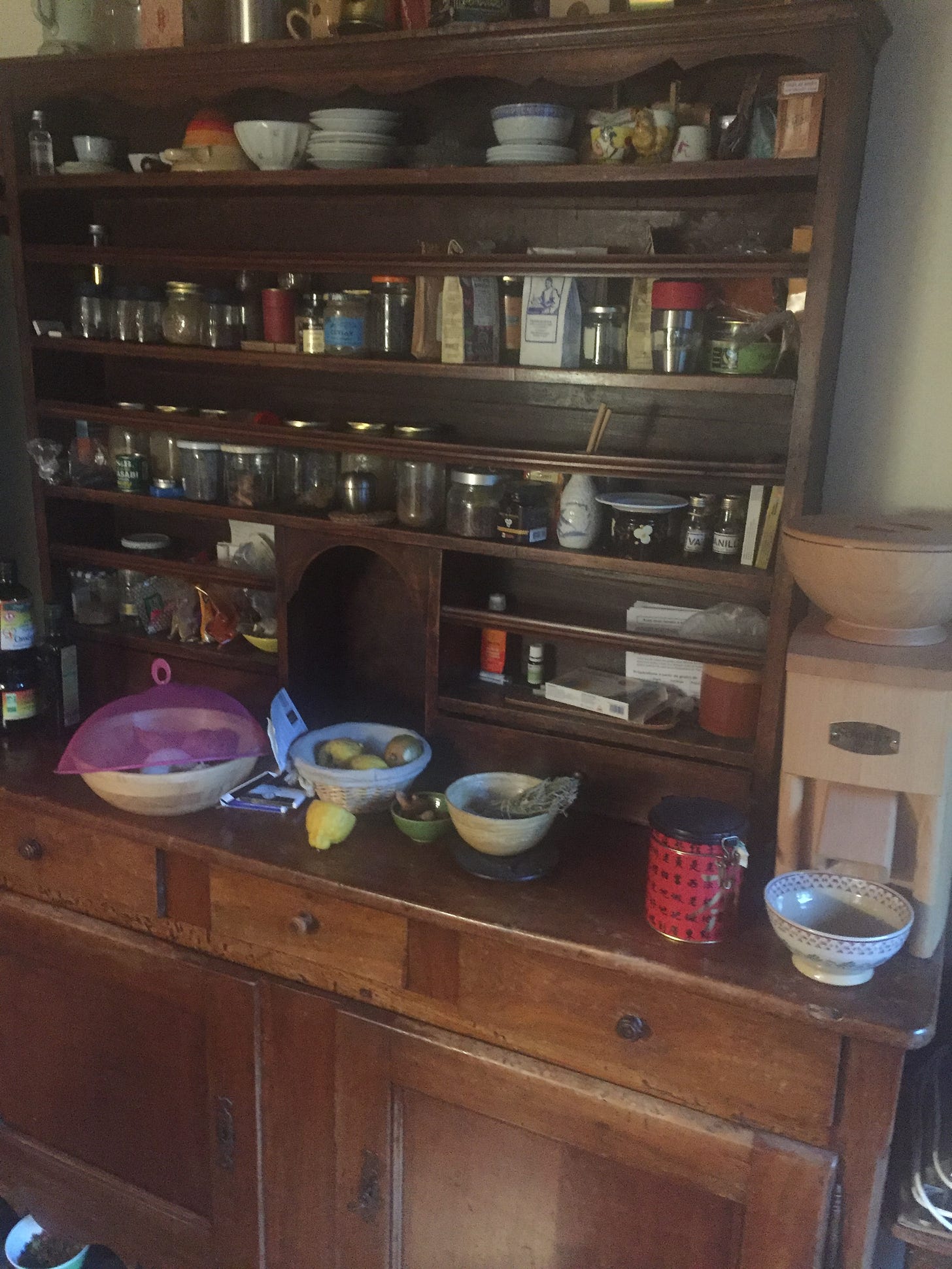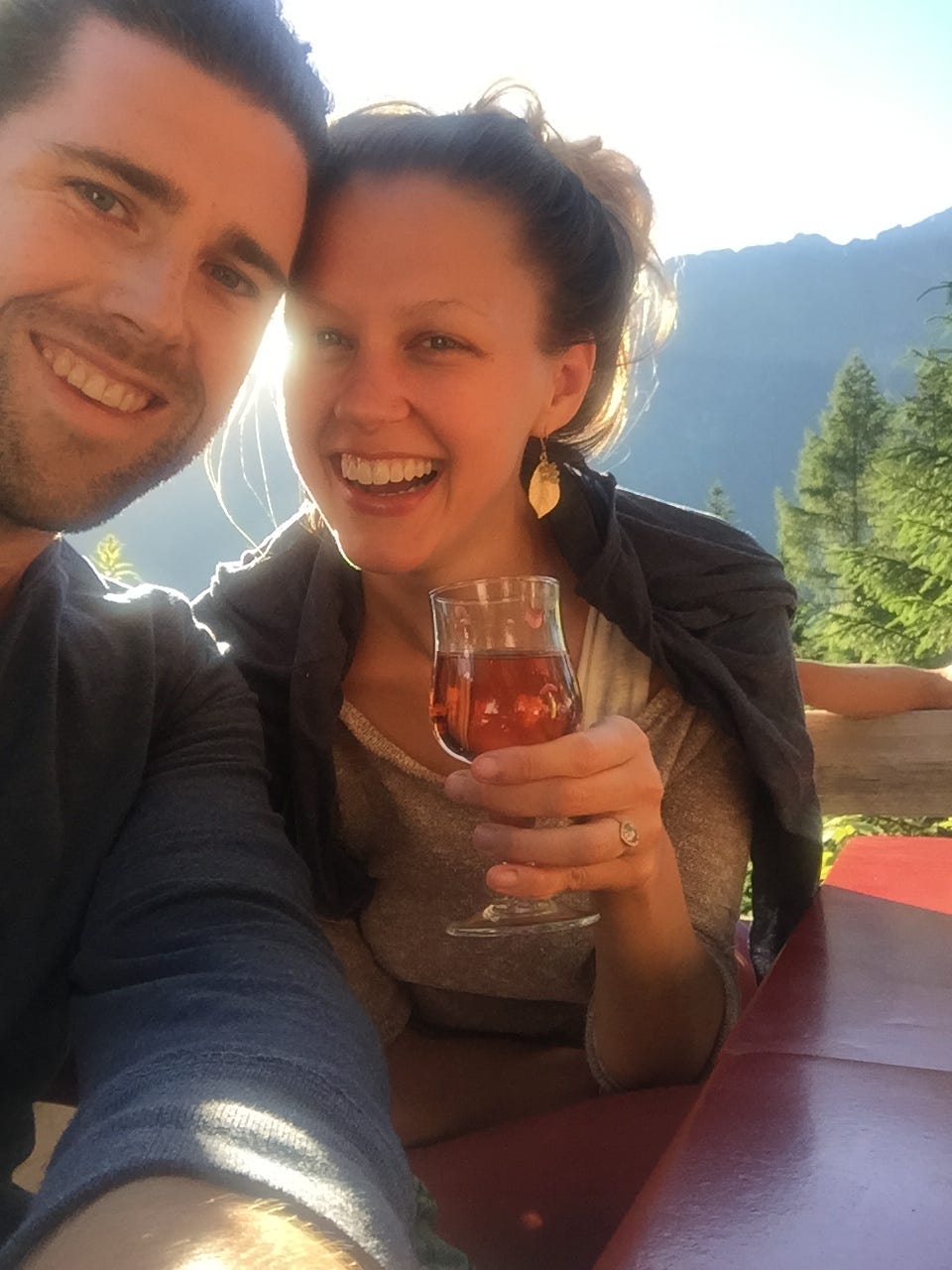THE view of contentment. Samoëns, France. 2016.
I have this very specific and embodied, felt-sense memory of a moment of pure contentment.
Contentment is not the same as happiness, though I’m sure I was happy in this moment too.
It’s more full-bodied presence.
Not needing to be anywhere else, but where you are.
It was late June, 2016. I was standing barefoot on a hillside in the French Alps, staring at the rolling fields of wildflowers and snow-capped peaks in the distance, holding a metal mixing bowl and licking chocolate avocado mousse off a wooden spoon.
The weather was that perfect Goldilocks-summer combination of sun, no humidity, and a light breeze that made you feel like you could dissolve into the air around you.
I had just waved goodbye to 40 or so lovely folks, mostly Europeans, who had joined us on a weeklong yoga retreat.
The retreat was taught by our teacher Simon. My husband Sam assisted him in the yoga room, while I assisted his-then-girlfriend, a dear, sweet young German woman named Coco in the kitchen.
We spent the week shopping the daily village markets for the freshest produce, eggs, and heavenly cheese. Soaking beans at sunrise that would become the day’s dinner. Boiling endless kettles of water for tea. Always placing freshly picked wildflowers alongside the plates.
Learning to mix dough and water and yeast together, kneading it by hand, feeling out all the ratios by touch. Too sticky? Add more flour. Not wet enough? Add more water. Don’t be too precious about it. Not rocket science. Most definitely an art.
Preparing 3 meals each day for this group alongside Coco and any straggling yogis who wandered into the kitchen to sit and chop and chat alongside us.
We had arrived 10 days earlier to this literal French Country farmhouse.
Phillipe, the 60 or so, still handsome and charming host, with his long salt & pepper hair and thick French accent, proprietor of the house, called Le Dojo, welcomed us in.
He shuttled us around the cobblestoned path that ran alongside the house to the back, where the kitchen was.
To the left of us, as we walked, I caught my first glimpse of the dreamy rose garden, climbing the walls of the root cellar, built into the earth, which I would visit countless times over the next 10 days, because all the produce, cheese, eggs, and wine (aka all the good stuff) were kept there.
This actual French Country kitchen was the opposite of any Americanized-version of the style I had been trained to expect.
No built-in-builder-grade-white cabinetry running to the height of soaring ceilings in some stadium-sized cavernous McMansion.
The house was built into the hillside, using stone that had always been there as part of the foundation.
The kitchen was in that stoney, cool, almost-basement of the back-of-the-house. A true “ground floor” that opened up into a lovely little garden where we ate our meals.
An old wooden dresser kept the mismatched plates, cups, cutlery, bowls, and serving dishes. And the ceilings, in fact, were very low. The old stove had to be manually ignited with a match.
And — likely to the horror and shock of any American homeowner with their own “French Country” kitchen, with its gleaming white marble — everywhere you turned, thin uncoiling strips of fly paper hung from the ceiling, covered with (you guessed it) flies. Little wire nets tented over bowls filled with food on the counter, also to keep the buzzing flies out. And adorable just-born kittens everywhere… bringing the dead mice they caught daily, right to your feet.
We had arrived that night after a wild road trip, hauling a van full of produce from the Bavarian Alps through the Swiss Alps and finally to the French Alps, which would be our home for the next several weeks. (I’m betting that the statue of limitations on our international border / culinary crime has expired as I tap essay this out in late June 2024. If not, then I’m adding that fictional detail for flourish, ok?).
If you’ve never done this drive before, it is exhilarating in an oh-my-gosh-are-we-going-to-die-kind-of-way. Hairpin turns and sheer drops, as the roads wind up and down these massive ancient mountains. Barreling over bridges, with thin, stone legs that look like stilts in between curved arches, careening us over icy cold Alpine streams, hundreds of meters below.
We came in HOT to Phillipe’s cool French Country farmhouse that first night, late into the evening.
Let’s call it 10pm.
But it’s an early summer, European 10pm, so it’s a sun-just-set-absolutely-still-acceptable-time-for-dinner 10pm.
Phillipe poured us all the first of many, many red wines into little cafe cups and we sat around his low table in the center of his kitchen — no massive American island in sight — on mismatched chairs, as he finished cooking us the simplest and most memorable dinner I’ve ever eaten.
In a low-slung, warped-over-time wooden bowl sat a lively mix of lettuces, lightly dressed by hand with no more than a little olive oil and a pinch of salt. A warm loaf of bread sat on an also-warped wooden board.
We tore chunks off by hand and paired it with slices of Tomme de Savoie, the humble everyday cheese from this region that tastes exactly like how it smells outside that we cut with an Opinel pocket knife.
Phillipe stood over the hot stove, cascading flakes of sea salt from on high over an impossibly heavy cast iron skillet filled with potatoes, diced up and likely dug up from the ground in the garden the late summer before and stored in the root cellar filled with wine and covered with roses. He added more butter and shook the pan around, as the potatoes perfectly crisped on the outside, still soft on the inside.
Dinner was served.
We carried these simple dishes — salad, potatoes, bread, cheese, and wine — out to an old rickety table in the garden, covered in a plasticky table “cloth” — somehow still chic — and sat around it and under the stars and ate and drank until not a crumb or a drop was left.
The first of many “French Dinners.”
Simple. Humble. Attentive. Pleasurable.
No schedule, no rush, no fuss. Utter care taken on everyday ingredients. Dishes prepared thoughtfully but without pretense. Life meant to be enjoyed and shared.
So by the time I got to that utterly content moment, 10 days later, licking the chocolate mousse off the wooden spoon and waving goodbye to our people, I had created — whether I realized or not at the time, I don’t remember — a lasting muscle memory for how I now live, how I host, how I nourish, how I gather, and how I work in a seamless and cohesive way.
On that third summer after leaving Big Law, during this month in France, the lawyer officially left my body.
Forget balance, this — this was wholeness.
Now, nearly a decade to later, my life back in America has gotten a bit more chaotic and crazy, filled with wild kids with boundless energies, businesses to run, and at times, of course, hardship, loss, stress, fear, and worry.
But we have never abandoned the French Dinner. It always brings us back.
It lives in our bones, its memory still nourishing us and its imprint our blueprint for making summer dinners, now nearly a decade later, in our Hudson Valley farmhouse, usually with a side of a frozen Dino nuggets for the younger set. Because this is both real life and Real Life.
To me, the French Dinner is vitality and attention, embodied in literal nourishment that we eat, that we take inside.
It’s not the farmhouse, it’s the mindset.
It’s Annie Dillard’s, “How we spend our days is … how we spend our lives.”
It’s Wendell Berry’s, “What we need is here.”
It’s Mary Oliver’s, “Instructions for living a life. Pay attention. Be astonished. Tell about it.”
It’s the juice of a ripe summer tomato. It’s the impossibly fresh pop of basil from the pot on the porch. It’s the rumpled linen on the table. It’s the wine poured into jelly jars. And flowers clipped from the garden, wild and blessed. It’s why and how we gather. It’s the ease. It’s the peace (even in the chaos of kids). It’s the joy of simply being together.
It’s slowing down to welcome someone at your door — even if it’s “just” yourself, maybe especially if it’s “just” yourself” — no matter how “late” it is. And saying, “Here. Sit down. Relax. I made this for you. And you are so, so welcome here.”
French Dinner: A Recipe for Presence
Here’s my take. It’s actually more “formula” than recipe. (If you came looking for exact measurements, you are in the wrong place. If you came for pure pleasure, you are in the right place.) Adjust portions, actual ingredients, to size of the crowd, taste, and season. Don’t skip or skimp on the essential instructions and invitations.
First, set the literal table. This can be done at a leisurely pace, any time in the afternoon. No rush. It’s not so much about cleaning and it’s definitely not about perfection. But let it be stunning. Let it feel like a soft place to land. Candles. The linen you don’t iron. Flowers are necessary. And a small dish of flakey sea salt on the table too. The rest is up to you.
Next, make sure you feel beautiful too. Put on your favorite music, if that’s your thing. Dab on a little make up, if that’s your thing. Tuck your hair into a pony, if that’s your thing. Wrap an apron around you, if that’s your thing. I cook barefoot this time of year. Definitely not restaurant-kosher, but this is French Country farmhouse cooking at home, by me. Pour yourself a glass of something lovely to sip while you cook. Spindrift decanted into a stemmed wine glass is a great we’re-not-actually-in-France-and-it’s-Tuesday-night option ;)
Bread: don’t be afraid to make it yourself. This requires some planning in the morning, but I’m telling you it’s simpler than it seems. And it’s SUCH a great party trick. No one can resist, still-warm-fresh-out-of-the-oven bread with salted soft butter, even in the summer. I bake bread all the time since learning that summer in France. It’s the same intuitive approach Coco taught me, with some extra practice homed with my sister-in-law Kyndal, and a nod to Jim Lahey’s no-knead bread dough recipe.). Or buy something beautiful, local, baked that day with care and love, if you can. Oooo only have stale-ish bread? My other sister-in-law Mary taught me this: soak the loaf in running water from the kitchen sink (I’m serious.) And I think she counts to 10, slowly, as she soaks it. Pop it in the oven (350? not sure? You’ll have to ask Mary or just experiment yourself) for a couple minutes (call it 10? but check it at 5? Go longer if you need to, obviously). Serve with soft, salted butter on a warped wooden board. Use your hands to tear it. Or cut it with a knife
Don’t forget the cheese. We’re lucky to have great local Hudson Valley and almost-local Vermont cheese in half-a-dozen little farm stores or cheese shops within a 15-minute drive from where we live. Do your best. If there’s a place to splurge on your menu, it’s here. You only need one kind. Better than “good enough.” One good cheese is more than enough.
Don’t skimp on the beverages. Whatever you’re serving, from N/A beers to seltzers to bottles of wine. Have enough. Too much, even. With any leftovers, you’re already all set for the next impromptu French Dinner party.
The SALAD: Get the freshest lettuces you can find. Picked from your own garden if you’ve got a greener thumb than I. Or if you’re me, from one of those farm stores or the Saturday farmer’s market. Washed and VERY dry. Served in that low-slung wooden bowl. I dress with olive oil, fresh lemon squeezed over it (usually “too much” for my husband’s taste, but I like a POP!), and flakey sea salt. Dress by hand and feel — seriously, coat and toss with your own clean hands. You can even serve with your own clean hands. If I’ve got a heartier green, like the kale we picked last week from the farm, I usually add some finely chopped garlic, homemade croutons. Just coat chunks of leftover bread with oil, salt, seasonings. Bake at 350 till you smell it, but it’s not burning. Cool and this will store in a sealed container or baggie for … weeks! I sometimes place the breadcrumbs in a baggie and whack them with the back of a wooden spoon or measuring cup to break into carby, crunchy, adult sprinkles.
The VEGGIES: Can be potatoes, in true Phillipe fashion. Or whatever is fresh and accessible and you’re craving. Right now, we grill everything and add lots of fresh herbs. Or cook inside, quickly in a wok or cast iron skillet, very hot.
Optional, if you’re feeling fancy or very hungry: A protein (fish, steak, chicken). But I’m telling you — it’s not necessary. Need a swap? I guess rice or some other grain and definitely warmed flour tortillas can replace the bread. And confession, that’s what we usually do during the week, the rice! Also, picnic blankets sub for tables just fine. We also use the same bread dough recipe for homemade pizza, and I cannot recommend this swap more. The whole French Dinner, in one handheld bite.
Sit DOWN and let your French Dinner unfold. If you have guests, even if they are “just” your family, let them help you! (It goes like this. Them: “Can I help you with anything?” You: “YES! you can open the wine / set the table / slice the bread / dress the salad / play with the kids while I cook / pick the herbs / fill-in-the-blank”). Try not to rush or worry about bed times (or give the kids a screen while you sit a bit longer, I’m not judging). Bonus if you let the candles burn to the end. Double bonus if you light a fire in the yard and move the party over there. Triple bonus if you leave the table to finish cleaning in the morning. I love walking down to the imprint of the night before, crumbs, crumpled napkins, empty glasses, stray unused knives.
That’s all. Enjoy it all. Every last bite and sip.
Below are some pictures of French Dinners, including some trips back to France, over the years.
Share a pic of yours or a comment below on how it goes if you make French Dinner this weekend.
LOVE,
Cath xo
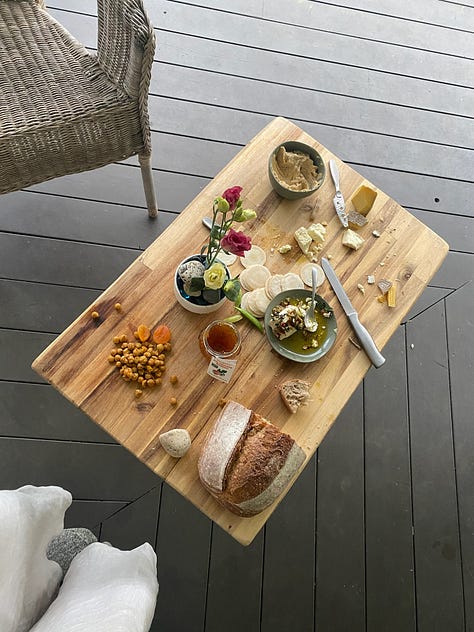
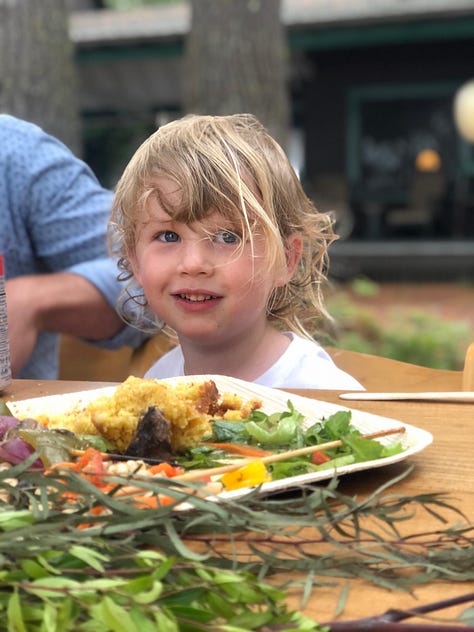
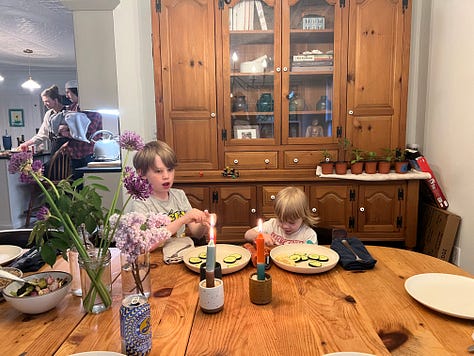
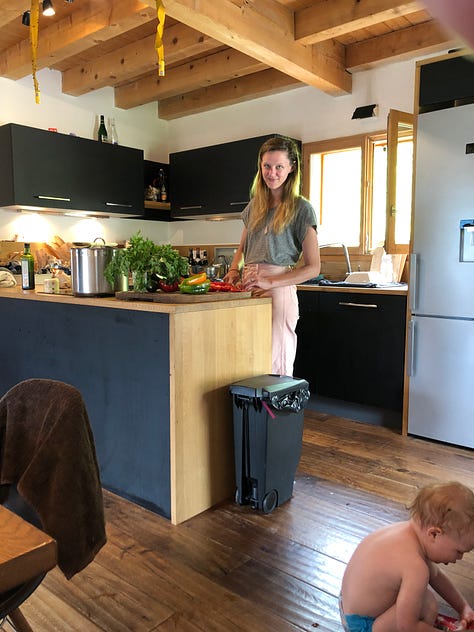
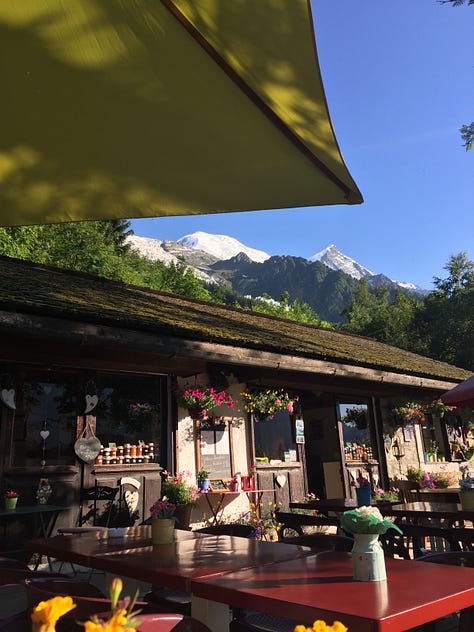
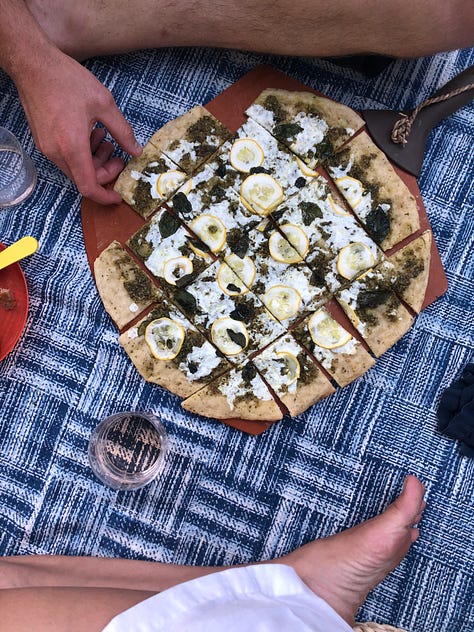
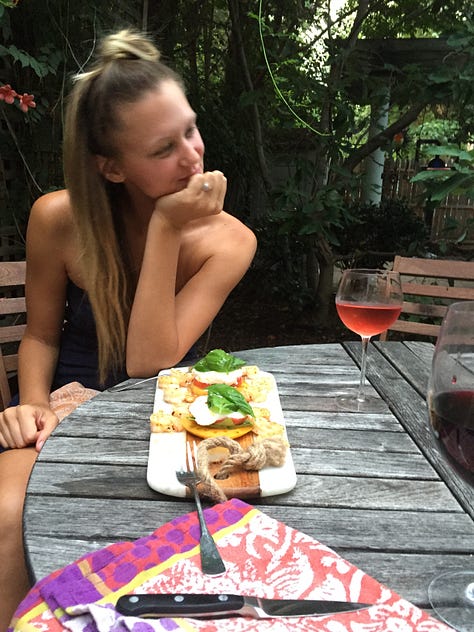


some French Dinners of all shapes & sizes, over the years. Including, back to France ;)
AUDIO VERSION FOR THE PAID SUBSCRIBERS — LOVE! 👇
Keep reading with a 7-day free trial
Subscribe to Let's Sit Together to keep reading this post and get 7 days of free access to the full post archives.


